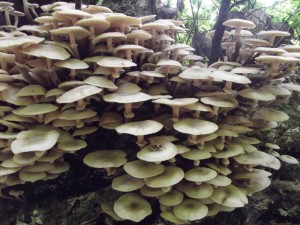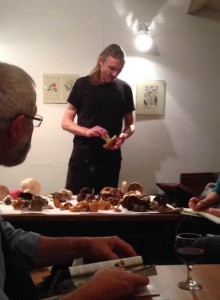Email: geoffdann@hotmail.com
Phone: 07964 569715
10/10/2013
Temperatures across the UK have plunged several degrees. It was T-shirt weather just two days ago, but I needed a coat this morning. The first major fall of leaves is also underway in the deep south, and there has been a changing of the mushroom guard as the late summer species fade away and the mid-autumn species make their first appearance.
I saw clouded funnel (Clitocybe nebularis) for the first time yesterday, which generally marks the halfway point in the progression of autumn-fruiting fungi. This species likes growing right next to roads and is recognisable as you drive past at 60mph, which leaves little doubt about just how common it is. It never has an off-year. Shame it smells of vomit! Anyway…it reliably turns up at the mid-point of the mushroom season and that is right now.
A wide selection of Tricholomas have also appeared in the last few days, along with another species which never has an off-year: honey fungus (Armillaria) is so super-abundant as to make even the displays of Clouded Funnel look sparse. Combined with the fact it is a virulent parasite and serious forestry/horticultural pest, this means that unlike so many other good edible fungi, foragers can eat Honey Fungus to their heart’s content with absolutely no worries about sustainability or the ethics of taking lots of stuff. The only problem with taking too much of this one is that you might end up with more than you can consume, and you absolutely do not want to be putting any on your compost heap – not if you value the trees and shrubs in your garden, anyway.
I can’t help but associate the word “army” with “Armillaria”; the fruit bodies seem to march across some logs and stumps just like an army on the move. In many cases this fungus will have been the cause of death of those trees – it is one of the few organisms which is both parasitic and saprophytic – capable of killing a living tree and then continuing to feast on its corpse. If you fancy feasting in turn on it then make sure you cook it well and be aware that some people suffer gastric problems after consuming it. My favourite way to cook it is in the roasting dish with a fatty joint of meat, or fried for ten minutes in bacon fat. Long cooking reduces the chance of a reaction, apparently. Either way, it is very tasty.
“Armillaria” does not have any connection with armies, by the way. It derives from the latin “armilla”, meaning “bracelet” and refering to the bracelet-like ring on the stem (see picture). This is one of the identifying features of the species (although there is a ringless form). It’s not the easiest fungi to identify, owing to there being so many other species which grow in great tufts from decaying logs. The pattern on the cap is probably the most helpful indicator, but my advice is just to look at quite a few pictures on the internet and keep your eyes peeled for the next couple of weeks. You will soon learn how to recognise it, and once it is familiar then the only thing you might get it mixed up with is one of the Pholiota species, none of which are seriously poisonous, although some of them don’t mix well with alcohol.
2013 is also (apparently) turning out to be a vintage year for the chanterelle family. I’ve been seeing considerably more chanterelles (Cantherellus cibarius) than normal, winter chanterelles (Craterellus tubaeformis) have appeared earlier than normal, yesterday’s group of foraging students happened across a the largest fruiting of horns of plenty (Craterellus cornucopioides) I’ve ever seen and we also found the very rare velvet chanterelle (Cantherellus friesii). To top it all, somebody posted a picture yesterday at Wild Mushrooms Online of the even rarer ashen chanterelle (Cantherellus cinereus).
As a final note I’d just like to thank The Garden House for hosting a highly enjoyable fungi talk last Friday, a review of which can be found here.


